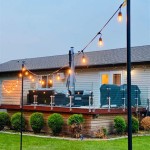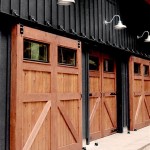Outdoor Lighting for Ranch Style Houses
Ranch style homes, characterized by their single-story design, low-pitched roofs, and sprawling layouts, present unique opportunities and challenges when it comes to outdoor lighting. Effective outdoor lighting not only enhances the curb appeal of a ranch house but also significantly improves safety, security, and the overall enjoyment of outdoor living spaces. Thoughtful planning and careful selection of lighting fixtures are crucial to achieve the desired aesthetic and functionality.
The horizontal emphasis of ranch style architecture calls for a lighting approach that complements this design element. Overly tall or ornate fixtures can appear disproportionate and detract from the home's inherent simplicity. Instead, the focus should be on low-profile lights, strategically placed to accentuate architectural features, illuminate pathways, and create a welcoming atmosphere.
Consideration must also be given to the surrounding landscape. Ranch homes often boast expansive yards and gardens, which can be effectively integrated into the lighting plan. Lighting can be used to highlight mature trees, flower beds, and water features, extending the living space beyond the confines of the house itself. The goal is to create a cohesive and harmonious outdoor environment that is both beautiful and functional.
Key Point 1: Enhancing Curb Appeal Through Strategic Fixture Placement
Curb appeal is paramount for any homeowner, and outdoor lighting plays a significant role in creating a favorable first impression. For ranch style houses, strategically placed lighting fixtures can draw attention to desirable architectural details and landscaping features, while minimizing the impact of less appealing elements.
One of the most effective ways to enhance curb appeal is through the use of pathway lighting. Low-voltage path lights can be installed along walkways leading to the front door, providing both illumination and guidance. These lights should be spaced evenly and positioned close to the ground to avoid glare and ensure a subtle, yet effective, glow. Consider using fixtures with a warm color temperature to create a welcoming ambiance.
Another important area to illuminate is the front porch or entryway. A well-lit porch or entry not only enhances safety and security but also adds a touch of elegance to the home's facade. Consider using sconces or pendant lights on either side of the front door, or a single, larger fixture centered above the entrance. The style of the fixture should complement the overall architectural style of the house. For a more modern ranch, sleek and minimalist fixtures may be appropriate, while a more traditional ranch may benefit from fixtures with a more classic design.
Highlighting architectural features such as stone cladding, brickwork, or interesting window details can also significantly enhance curb appeal. Uplighting, which involves placing fixtures at the base of a wall and aiming the light upwards, can be used to accentuate these features and create a dramatic effect. In contrast, downlighting, which involves placing fixtures above and aiming the light downwards, can be used to create a soft, ambient glow.
The mailbox and house numbers are often overlooked when planning outdoor lighting, but they are essential for visitors and emergency services. Consider installing a small light fixture near the mailbox to make it easily visible at night. Similarly, illuminate the house numbers with a spotlight or a dedicated number light to ensure that they are easily readable from the street.
Finally, be mindful of the overall lighting scheme. Avoid creating a patchwork effect by using too many different types of fixtures or by placing lights haphazardly. Instead, strive for a cohesive and balanced lighting plan that enhances the home's architectural features and creates a welcoming and inviting atmosphere.
Key Point 2: Prioritizing Safety and Security with Effective Illumination
Beyond aesthetics, outdoor lighting plays a crucial role in enhancing safety and security. A well-lit property deters potential intruders, reduces the risk of accidents, and provides peace of mind for homeowners. Focusing on key areas and using appropriate lighting techniques is essential for maximizing the security benefits of outdoor lighting.
One of the most important areas to illuminate for security purposes is the perimeter of the property. Motion-sensor lights are particularly effective in this regard, as they automatically activate when movement is detected, alerting homeowners to potential intruders and deterring unwanted guests. These lights should be strategically placed at vulnerable points around the property, such as near windows, doors, and gates.
Pathway lighting also contributes to safety by illuminating walkways and preventing trips and falls. This is especially important for ranch houses, which often have long, sprawling walkways. Ensure that pathways are adequately lit with evenly spaced fixtures that provide sufficient illumination without creating glare.
The backyard is another area that requires careful consideration when it comes to security lighting. Install lights along the fence line or near outbuildings to deter intruders and provide a sense of security. Consider using timer-controlled lights to simulate occupancy when the house is unoccupied.
In addition to general lighting, consider installing security cameras with integrated lighting. These cameras can provide a clear view of the property, even in low-light conditions, and can record footage for later review. The integrated lighting can also act as a deterrent, discouraging potential intruders from entering the property.
Dark Sky compliance is an important consideration when planning outdoor security lighting. Dark Sky regulations aim to minimize light pollution and protect the night sky. Choose fixtures that are shielded and direct light downwards, minimizing the amount of light that is emitted upwards. This not only reduces light pollution but also improves visibility by reducing glare.
Regular maintenance is essential for ensuring that security lighting remains effective. Check fixtures regularly to ensure that they are functioning properly and replace bulbs as needed. Trim trees and shrubs that may be obstructing the light, and clean fixtures to remove dirt and debris.
Key Point 3: Creating Inviting Outdoor Living Spaces Through Layered Lighting
Ranch style homes often feature expansive outdoor living spaces, such as patios, decks, and gardens. Thoughtfully designed outdoor lighting can transform these spaces into inviting and functional areas for relaxation, entertaining, and outdoor dining. The key is to create a layered lighting scheme that combines ambient, task, and accent lighting to achieve the desired effect.
Ambient lighting provides the overall illumination for the space. This can be achieved through the use of overhead fixtures, such as string lights, pendant lights, or recessed lights. String lights are a popular choice for patios and decks, as they create a festive and inviting atmosphere. Pendant lights can be hung over outdoor dining tables or seating areas, providing both illumination and a focal point. Recessed lights can be installed under eaves or awnings, providing a subtle and unobtrusive source of ambient light.
Task lighting provides focused illumination for specific activities, such as grilling, reading, or preparing food. Consider installing a dedicated light fixture near the grill to provide adequate illumination for cooking. A portable lamp or sconce can be used to provide task lighting for reading on a patio or deck. Under-cabinet lighting can be installed in outdoor kitchens to provide ample illumination for food preparation.
Accent lighting is used to highlight specific features of the outdoor space, such as plants, sculptures, or architectural details. Uplighting can be used to accentuate trees or shrubs, creating a dramatic effect. Downlighting can be used to illuminate pathways or highlight water features. Spotlights can be used to draw attention to sculptures or other decorative elements.
The use of dimmers is highly recommended for outdoor lighting. Dimmers allow homeowners to adjust the brightness of the lights to suit different moods and activities. For example, bright lighting may be desired for entertaining, while softer lighting may be preferred for relaxation. Dimmers can also help to conserve energy by reducing the amount of electricity consumed by the lights.
Consider using smart lighting systems that can be controlled remotely via a smartphone or tablet. These systems allow homeowners to turn lights on and off, adjust brightness, and even change colors from anywhere in the world. Smart lighting systems can also be programmed to automatically turn on and off at certain times, providing added security and convenience.
Finally, be mindful of the impact of outdoor lighting on the surrounding environment. Avoid over-lighting the space, as this can contribute to light pollution and disrupt the natural ecosystem. Use shielded fixtures that direct light downwards, and choose fixtures with a warm color temperature to minimize glare.
By carefully considering these factors, homeowners can create outdoor lighting schemes that enhance the beauty, safety, and functionality of their ranch style homes, transforming outdoor spaces into inviting and enjoyable areas for years to come.

9 Outdoor Lighting Ideas For Maximum Curb Appeal Brick Batten

9 Outdoor Lighting Ideas For Maximum Curb Appeal Brick Batten

Ranch Style Outdoor Lighting Store

How Outdoor Lighting Can Change Your Home Rainscapes

Architectural Lighting Brings White Ranch Back To Life At Night

Country Ranch Home Transitional House Exterior Napolis By Lighthouse Outdoor Lighting Of Houzz Ie

Outdoor Lighting For Home Exterior Lights

Country Ranch Home Transitional House Exterior Napolis By Lighthouse Outdoor Lighting Of Houzz Ie

Ranch Style House Outdoor Lighting See Description

Benefits Of Outdoor Security Lights For Vacation Season The Perfect Light








